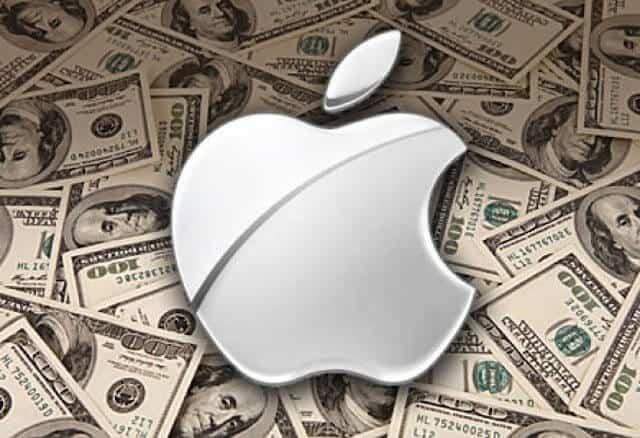With $43.8 billion in debt and more on the way, the importance of the Apple Inc. (NASDAQ:AAPL) cash pile is surely diminishing. The firm which is regularly celebrated for its humungous cash pile is also collecting a prodigious amount of debt under CFO Luca Maestri. With a $7 billion debt offering on the cards on Wednesday, that cash pile is worth less than it used to be.
According to a Bloomberg report written by Michelle Davis and Cordell Eddings, Apple plans to issue debt in as many as seven parcels, with the longest duration issue reaching maturity in thirty years. Today’s issue is the fourth massive bond sale by Apple in less than three years.
Since Apple shares hit all time highs on the back of the company’s recent earnings report, the company has shed a full $50 billion of value.
Apple folds to shareholder pressure
It is, contrarily, the cash itself that’s forcing Tim Cook to get issue more debt. The company’s massive cash pile caused hedge fund managers like David Einhorn and Carl Icahn to call on the company to return the uninvested money to shareholders. Apple, after much direct pressure, agreed to do so in the form of a dividend and a stock buyback.
That capital return program hit $200 billion after the boost announced by Cook and Maestri at the company’s second quarter earnings release. The Cupertino company cannot, however, afford to bring cash into the United States from its international hiding spots because of a hefty repatriation tax. The answer to this problem, caused by the massive cash pile in the first place, is for the company to issue more and more debt.
To see a list of high yielding CDs go here.
Trip Chowdhry, an analyst following Apple for Global Equities Research, recently admonished Mr. Maestri for his part in the capital return program debt splurge. The analyst, who is very bullish on Apple’s prospects overall reckons that the capital return program amounts to a “Borrow and Squander” policy.
Apple debt erases cash
With the $50 billion loss in value at Apple since the company’s all time highs, and the firm’s mounting debt pile the value of the cash it hasn’t used to leverage lower interest rates may be degrading. The company is still, as , Citi technology analyst Jim Suva recently delineated on CNBC “a cashflow machine,” but it is having trouble turning that cash flow increase into a similar increase in share value.
There’s absolutely nothing wrong with Apple Inc. right now, and $50 billion in debt on a $200 billion cash pile isn’t a huge burden for a business, particularly one with Apple’s growth rates. What is a problem, however, is shareholder unrest at the loss of $50 billion in total value over the course of a couple of weeks.
Tim Cook and his executive team have been keeping investors happy thus far with their redistributions, but there may come a point of diminishing returns on them. Analysts like Tim Arcuri of Cowen and Company are predicting lower growth in the iPhone sector in the years ahead and Apple may end up cash poor in the United States for fear of repatriation.
When speaking about the Apple cash pile, however, it’s no longer appropriate to speak about it without relating it to the size of the company’s debt pile. Making apocalyptic predictions based on the $50 billion the company has in debt is charlatanism, but so is talking about the security of the $200 billion cash pile.
Apple CEO Tim Cook and his team will have a lot to deal with in the coming years, and it may be that Mr. Chowdhry’s “Borrow and Squander” policy will have to end. Apple currently has plans to return $200 billion through 2017. The company’s plans for its cash beyond that point are anyone’s guess.
Trusted & Regulated Stock & CFD Brokers
What we like
- 0% Fees on Stocks
- 5000+ Stocks, ETFs and other Markets
- Accepts Paypal Deposits
Min Deposit
$200
Charge per Trade
Zero Commission on real stocks
64 traders signed up today
Visit Now67% of retail investor accounts lose money when trading CFDs with this provider. You should consider whether you can afford to take the high risk of losing your money.
Available Assets
- Total Number of Stocks & Shares5000+
- US Stocks
- German Stocks
- UK Stocks
- European
- ETF Stocks
- IPO
- Funds
- Bonds
- Options
- Futures
- CFDs
- Crypto
Charge per Trade
- FTSE 100 Zero Commission
- NASDAQ Zero Commission
- DAX Zero Commission
- Facebook Zero Commission
- Alphabet Zero Commission
- Tesla Zero Commission
- Apple Zero Commission
- Microsoft Zero Commission
Deposit Method
- Wire Transfer
- Credit Cards
- Bank Account
- Paypall
- Skrill
- Neteller
What we like
- Sign up today and get $5 free
- Fractals Available
- Paypal Available
Min Deposit
$0
Charge per Trade
$1 to $9 PCM
Visit Now
Investing in financial markets carries risk, you have the potential to lose your total investment.
Available Assets
- Total Number of Shares999
- US Stocks
- German Stocks
- UK Stocks
- European Stocks
- EFTs
- IPOs
- Funds
- Bonds
- Options
- Futures
- CFDs
- Crypto
Charge per Trade
- FTSE 100 $1 - $9 per month
- NASDAQ $1 - $9 per month
- DAX $1 - $9 per month
- Facebook $1 - $9 per month
- Alphabet $1 - $9 per month
- Telsa $1 - $9 per month
- Apple $1 - $9 per month
- Microsoft $1 - $9 per month
Deposit Method
- Wire Transfer
- Credit Cards
- Bank Account



